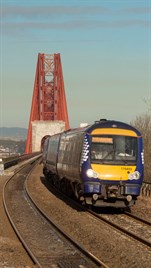 Read the peer reviews for this feature.
Read the peer reviews for this feature.
Download the graphs for this feature.
"If there is an industry cascade plan within the Department for Transport, it’s not one that is shared with stakeholders.”
Tim Burleigh should know. He’s Relationship Development Manager at Eversholt Rail, one of the UK’s three big rolling stock leasing companies.
He continues: “We all have our thoughts on how existing rolling stock could be deployed in the future. We share our thoughts with the Department, but we don’t get the same back.”
That certainly seems to be the official Government line. Asking for an explanation of the current state of the rolling stock market resulted in this cut-and-paste response from a DfT spokesman: “The Government believes in a market-led approach to rolling stock, and therefore does not believe that the cascade of units between franchises should be planned by officials within the Department for Transport.”
Certainly Burleigh believes there is a genuine market, with real competition to supply the most suitable trains to the appropriate users. Well, he would say that!
“Very much so. Very strong competition. With Thameslink particularly, Crossrail yet to come, and the Hitachi IEP order creating pools of existing rolling stock which has future potential use. There are more trains in some categories than there is current demand.”
But not everyone agrees with the DfT’s official stance.
“That’s bollocks. Utter bollocks,” says a very senior executive in the passenger rail industry, who prefers not to be identified (for obvious reasons).
“DfT claims it does not interfere in the rolling stock market. But in reality it does. There is a question about whether it is really a market anyway. When demand exceeds supply, normally supply is increased. That doesn’t happen for rolling stock in the UK, which is why we have a shortage of trains, particularly diesel ones. I would say it’s not a market.”
This is not a view shared by all train companies. MTR operates London Overground, and will soon take on the Crossrail concession.
“I’d say there is a genuine market,” says Jeremy Long, MTR’s CEO, European business. “Of course, the DfT has control over franchises, and it can put in place specifications which dictate much of the rolling stock. But as there is more demand than supply, everyone wants to get their hands on second-hand DMUs and EMUs. There is a lot of antiquated stock that the industry would like to see pensioned off, but as there isn’t a replacement available, then there is a market for those trains.”
There is a plan. It is called the Long Term Passenger Rolling Stock Strategy for the Rail Industry, and its purpose is to make clear the level of demand for new trains over the next 30 years. Now in its third iteration, it was updated at the beginning of March. It is put together by the ROSCOs, by the Rail Delivery Group, by the owning groups of train operators and by Network Rail, under the leadership of former Eurostar chairman Richard Brown.
The strategy discusses the relationship between the rollout of overhead wires and the rate at which new electric trains will need to be ordered.
It anticipates that the total passenger fleet will grow by between 52% and 99% over the next 30 years, and that the proportion using electric traction will rise from 69% today to more than 90%. This means that between 13,000 and 19,000 new electric vehicles will be required.
New trains
Last year’s version of the strategy stated that fewer than 100 new diesel vehicles would be needed, none of them in the present decade. Now there has been a sharp shift of emphasis. There is “a potential requirement for 350 to 500 non-electric vehicles, for a variety of urban stopping, rural stopping and inter-urban express services. In the longer term, up to 1,500 new self-powered vehicles may be required.”
These will be required because of the existing levels of crowding and strong growth in demand on non-electrified routes. The strategy also assumes that all 290 Pacer vehicles will have to be replaced - this is specified in the Invitation To Tender for the new Northern Rail franchise, for completion by 2020. Northern is the largest user of unpopular Pacers, which are also operated by Arriva Trains Wales and First Great Western.
To meet demand, there would have to be an average build rate in the coming years of a dozen vehicles each week. In the five years to April 2014, the build rate was a third of that figure… four a week.
The strategy also states: “Government policy is that rolling stock procurement should, other than in exceptional cases, be franchise-led.” Yet in the big recent orders, that has not happened.
Government led the way in procuring IEP trains from the Japanese company Hitachi (at the time of writing, the first vehicles are on board a ship heading to Southampton). Government led the way on buying new Thameslink trains from German manufacturer Siemens. And together with Transport for London, Government led the way on the Crossrail order from Bombardier in Derby. It is undeniable that politics plays a significant role in the procurement process.











